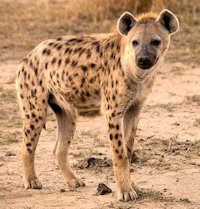
|
Some Common Myths Thought to be True - Myth 67
Myth 67: Mammals evolved from Modern Group of Reptiles
Mammals did not evolve from any modern group of reptiles. Soon after the
first reptiles appeared, they split into two branches, the sauropsids and the
synapsids.] The line leading to mammals diverged from the line leading to
modern reptilian lines (the sauropsids) about 320 million years ago, in the mid
Carboniferous period. Only later (in the late Carboniferous or early Permian)
did the modern reptilian groups (lepidosaurs, turtles and crocodiles) diverge.
The mammals themselves, being the only survivors of the synapsid line, are the
"cousins" rather than "siblings" of modern reptiles.
|
| Hyena | |
|
After the Cretaceous-Paleogene extinction event wiped out the non-avian
dinosaurs (birds are generally regarded as the surviving dinosaurs) and several
other mammalian groups, placental and marsupial mammals diversified into many
new forms and ecological niches throughout the Paleogene and Neogene, by the
end of which all modern orders had appeared.
|
|
| ⇦ Back to Myth 66 Return to Myth Choices Page 5 On to Myth 68 ⇨ | |